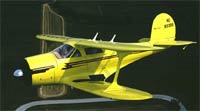
Staggerwing Beech:
“Classic” Redefined
The first time I flew a Beechcraft Model 17 Staggerwing it was a small engine (275 hp) model and was worth $15,000 at the most. The one I flew last year was a postwar, 450 hp “G” model that the owner had just paid nearly $500,000 to have restored. I strapped into a lot of different Staggerwings during the 25 years that separated the two flights and, although the prices may have escalated, they haven’t come close to keeping up with the growing grin factor that’s attached to flying one of the old girls.
As you open the thick, refrigerator-like door of a Staggerwing to climb on board, you quickly realize that they borrowed many of their design concepts from Packard. Or maybe Dusenberg. This thing isn’t an airplane. It’s an old-world limousine that just happens to fly. And fly well.
Steping through the door, you find yourself slightly bent over in the rear seating area that is three healthy people wide. Then you step between the two front seats and drop into the plush pilot’s seat to enjoy one of the most luxurious cockpits aviation has ever produced.
The nose rises well over your head but it is so rounded that right in front of you, and at an angle to your left, the visibility isn’t bad at all. Of course, if you really want to see, you can either crank down one of the plate glass side windows and hang your head out, or “S” turn on the taxiway. However, be advised: anything on the right side of the nose is invisible and it takes a very steep “S” turn to uncover it. The center of the taxiway/runway, however can be seen with only a minor wiggle of the nose.
It has been said many times, but it bears repeating, that there is no more delicious sound than that of a round motor firing up. In this case, it’s the legendary 450 hp, R-985 Pratt and Whitney. Crank a few blades through with the mags off to make sure there’s no oil in the bottom cylinders, flip the mags to “left” and you’re immediately rewarded with a raspy cough as bursts of blue smoke erupt out of the exhaust stacks.
As you line up on the runway, lock the tailwheel and slowly push the throttle to the panel, you’re immersed in a soul-satisfying symphony of horsepower. The airplane leisurely gains speed and lifts off in a stately manner befitting its limousine personae. As the nose comes down in level flight, the world reappears and the airspeed creeps up to the numbers that made the airplane appear magical in the 1930’s. Here was an airplane that claimed to deliver over 200 mph in cruise, which might as well have been Mach One in its day.
When WWII was over and Beechcraft introduced the svelte, and soon-to-be-legendary Bonanza, it would have been logical to assume that the day of the biplane was over. That was not the case, however. A segment of the market still wanted luxury so Beechcraft completely redesigned the airplane to make the windshield and cowling flow together in one of the most sensual shapes in any art form. Although barely a dozen and a half postwar G-17S’s were produced, they were, and are, considered by most to be a match for anything produced by Michaelangelo or deVinci. Besides, you can’t fly a statue.
Want another Peanut Pirep? Return to PEANUT.